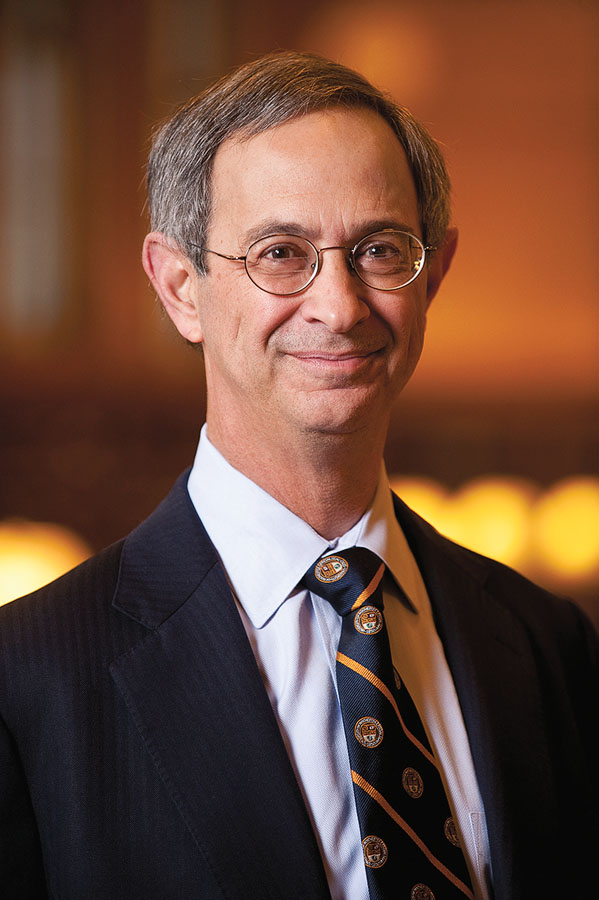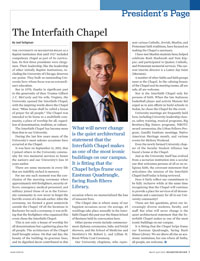President's Page
The University of Rochester began as a Baptist institution that until 1927 included compulsory chapel as part of its curriculum. Its first three presidents were clergymen. Their leadership, like the leadership of other initially Baptist institutions, including the University of Chicago, deserves our praise. They built an outstanding University here whose focus was on extraordinary education.
 (Photo: Adam Fenster)
(Photo: Adam Fenster)But in 1970, thanks in significant part to the generosity of then Trustee Gilbert J. C. McCurdy and his wife, Virginia, the University opened the Interfaith Chapel, with the inspiring words above the Chapel door, “Mine house shall be called a house of prayer for all people.” The Chapel was intended to be home to a multifaith community, a place of worship for all, regardless of denomination, tradition, or culture.
The Interfaith Chapel has become more than that to our University.
During the last few years many of the University’s most solemn occasions have occurred at the Chapel. It was here on September 11, 2011, that I joined others in the University community for two memorial services to honor the nation’s and our University’s loss 10 years earlier. There are some moments in every life that are indelibly etched in memory. For me one such moment was the conclusion of the morning ceremony when approximately 600 firefighters, security officers, emergency medical personnel, and military joined those of us in the University community to vow never to forget the horrific events of a decade earlier. After the ceremony, we formed a giant semicircle outside the Chapel. Of all the locations in Rochester for such a ceremony, it was striking that the firefighters who organized this event chose the Interfaith Chapel. This is not only a house of worship for all denominations but a gathering place for all people. The architecture of the Chapel itself brought solace. On that sad day, the beauty of the building, its gracious lines, and its dignified decor contributed to this occasion where we memorialized the loss of innocent lives.
The Chapel also is where many of our happiest occasions occur. On average, 45 weddings take place annually in the Interfaith Chapel; this past year the Simon School of Business held its convocation here. Other joyous events include commencement diploma ceremonies, baby and bridal showers, and the School of Medicine and Dentistry’s Dr. Robert L. and Lillian H. Brent White Coat Ceremony.
Our University chaplains, who represent various Catholic, Jewish, Muslim, and Protestant faith traditions, have focused on making the Chapel a sanctuary. I have met Muslim students here; helped celebrate Rosh Hashanah and Yom Kippur; and participated in Quaker, Catholic, and Protestant memorial services. The current interim director is a Latter-day Saint (Mormon). A number of other faiths and faith groups meet at the Chapel. In the calming beauty of the Chapel and its meeting rooms, all are safe, all are welcome.
Nor is the Interfaith Chapel only for persons of faith. When the late Sudanese basketball player and activist Manute Bol urged us to join efforts to build schools in Sudan, he chose the Chapel for the event. University meetings are frequently held here, including University leadership classes, safety training, musical programs, Big Brothers/Big Sisters programs, NROTC award ceremonies, the Urban Fellows Program, Gandhi Institute meetings, Native American Heritage month, and various events for Meliora Weekend. Even the newly formed University chapter of the Secular Student Alliance has found a home at the Chapel.
Just as the University itself has evolved from a sectarian institution into a secular one that welcomes persons of all or no religious faith, the covenant statement that articulates the mission of the Interfaith Chapel itself today is being reviewed. Does it fairly reflect our commitment to be fully inclusive while at the same time recognizing that the Chapel will continue to provide a place for services of all denominations and a sanctuary for all in our University community?
These are fair questions, given our increasingly diverse students, faculty, and staff. But what will never change is the quiet architectural statement that the Interfaith Chapel makes as one of the most iconic buildings on our campus. It is fitting that the Chapel helps frame our Eastman Quadrangle, facing Rush Rhees Library. We are above all else an academic institution, but one where all faiths, all people, are welcome.

